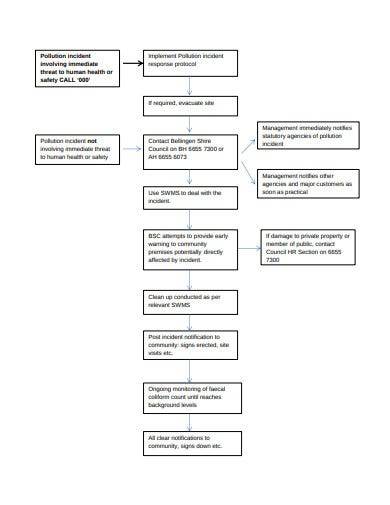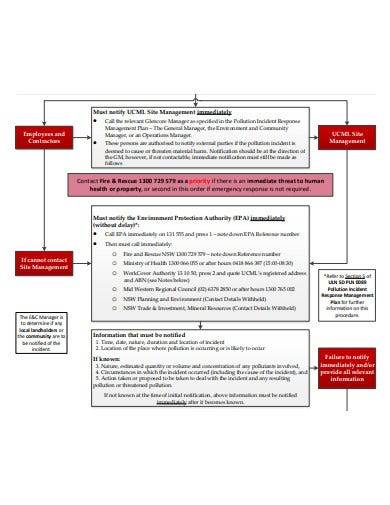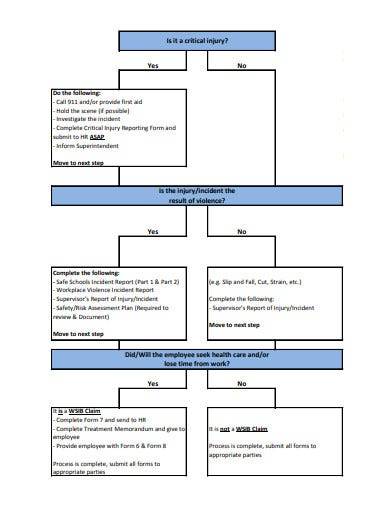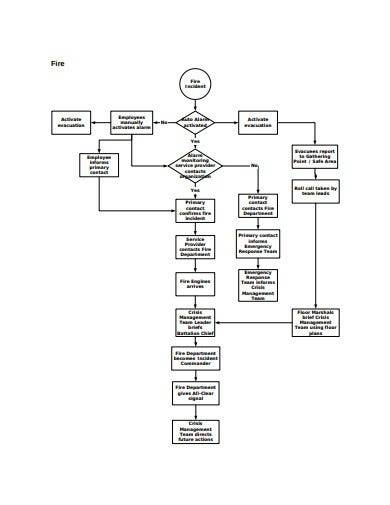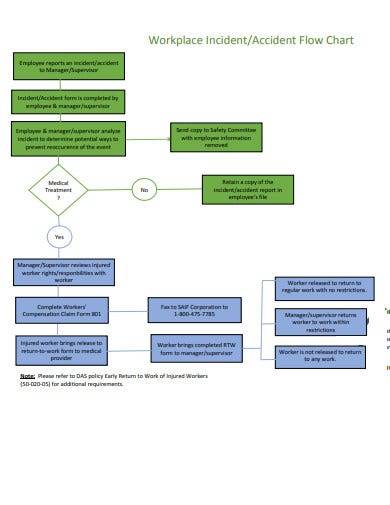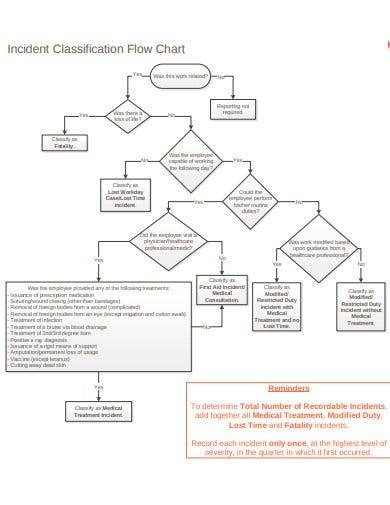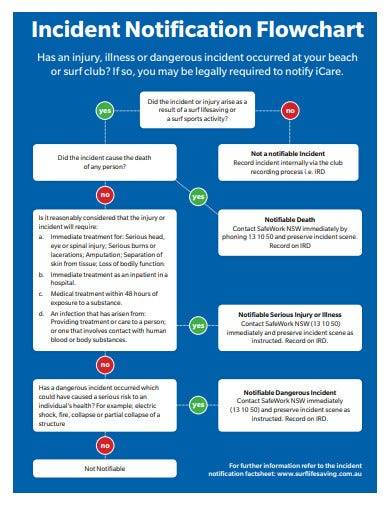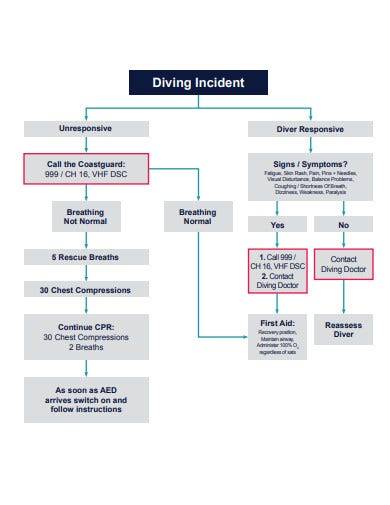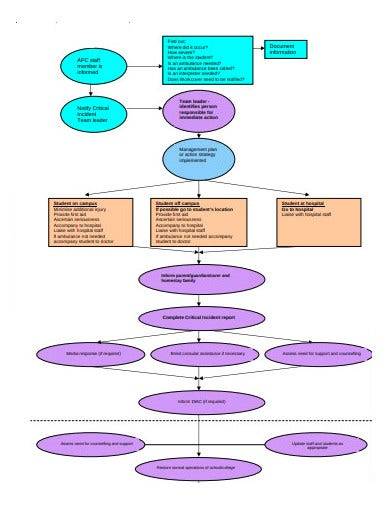Life never promised smooth-sailing waves. Whether you’re busy with your schedule or looking after a business venture, something is bound to go sideways later. It’s no use setting up protective systems and preventive measures when you don’t know how to face them head-on. The incident flowchart helps you establish an action plan of steps on how to handle these problematic circumstances. Read our article to learn more about this.
FREE 10+ Incident Flow Chart Samples
1. Incident Flow Chart Template
2. Sample Pollution Incident Flowchart
3. Sample Safety Incident Flowchart
4. Incident Report Flowchart Template
5. Sample Fire Incident Flowchart
6. Workplace Incident/Accident Flow Chart
7. Sample Incident Classification Flow Chart
8. Investigating Reporting Flow Chart
9. Incident Notification Flow Chart
10. Diving Incident Flow Chart Template
11. Formal Incident Flow Chart Template
What Is an Incident Flowchart?
An incident flowchart pertains to a diagram of steps on how to manage an incident. It shows how incident handling works towards its resolution. This is a necessary procedure to undertake when reports and complaints arise regarding a provider’s service. The use of flowcharts makes problem management more convenient because it’s easy to trace the path of action steps leading the solution through the aid of a visual presentation.
The Five Steps to Incident Management
With everything moving towards an all-digital era, most incidents come situations affecting the company’s systems, digital services, and cybersecurity. According to CNBC, cyberattacks costs $200,000 on average, targeting 43% of small businesses. Unfortunately, 60% of them shut down their operations after only six months. In a statistic featured by TechRepublic, there were a whopping 2 million cyber incidents in 2018. The loss amounted to $45 billion. The numbers involving information technology threats can break banks in half and tear businesses to shreds.
While it’s important to have a formidable security shield and other forms of protective suits to keep your operations from hazards, the way you handle these threats is equally significant. Here are five practical steps to incident management:
1. Report. Receiving incident reports and acknowledging that something went haywire is the first step to solving any problem. Even when you’ve groomed your systems to be in the best condition and discussed the company policy to avoid unwanted situations, always be ready to answer to incidences.
2. Investigate. Immediately address the report by finding out how the incident occurred. Understanding its background leads to knowing how to resolve the situation.
3. Analyze. Brainstorm strategies and procedures on what action plan best fits the scenario. Employ all necessary help to sot out the circumstance and restore the affected area to its stellar form.
4. Correct. Apply the best way to solve the problem based on the results of your investigation and analysis.
5. Learn. Allowing the same problem to fester over and over again after it was supposed to be restored numerous times corrupts your system. Once you’ve identified an incident, acknowledge the possibility that it can come up again and propose a long-term solution.
How to Create an Incident Flowchart
Here are some useful steps to help you make an incident flowchart:
1. Define the Incident
To get to the bottom of an incident, it’s necessary to understand the background of what happened. Start your flowchart by identifying what the incident is all about. Gather the details surrounding the report or a complaint. Acting without fully knowing the incident makes it hard to find the root of the problem. For example, if the incident came from a client’s dissatisfaction with your service’s performance, ask what happened and what event led to the situation. This allows you to devise a plan or respond to resolving the complaint and restoring your service back to its assigned service level.
2. State Incident Response
Once you have noted the incident details, including the notification date and the complainant’s name, you need to identify whether the problem is urgent or not. Examine the situation and determine if it’s something that a quick fix can suffice or there’s a need for a lengthy process to make it alright. This stage of the process flow finds out how you can handle the problem and who’s responsible for it. For example, suppose you’re in the technical support team catering to customer service. In that case, you might be able to help your client find a resolution through a series of instructions on a manual, or you can redirect them to another professional for expert help.
3. Identify the Mode of Escalation
Identify the teams who will receive escalated grievances. They will be the ones who will conduct the investigations and the diagnoses for incidences that are beyond the initial team’s control. While the help desk or the first level support team can usually answer most incident reports, some challenges require the result they can’t offer. These specialized teams handle incident response during these circumstances. As you make your incident process flowchart, identify who these individuals or teams are and their roles and positions. This way, it’s easier to direct help to hem.
4. Propose a Resolution
Once you have identified the list of problems, investigated the root and the needed procedure, and decided on the incident’s escalation, it’s time to give the resolution and inform the client or the complainant that resolve is underway. Remember that incident management doesn’t only focus on fixing what went wrong, but also to ensure that it will never occur again. This should be among your priority when handling any incident and in making your incident response process flow.
FAQs
How do you differentiate an incident from a problem?
An incident is one isolated unexpected event or disruption, while a problem is characterized by a series of different incidents.
What are the three types of incidents?
The three types of incidents are major incidents, repetitive incidents, and complex incidents.
What are the different elements of a flowchart?
The different elements of flowcharts are input, output, standardizations, order, activities, and participants.
Keeping your customers satisfied and protecting your interest both in internal and external matters is a task you constantly need to overcome. Incidences are inevitable, and the only way to subdue them is to be always ready for any reports and situations that may arise. Our high-quality incident flowchart templates can help you manage your operations efficiently. Get your selection from our collection now!
Related Posts
FREE 5+ Pert Chart Samples in PDF
FREE 8+ Blood Type Chart Samples in PDF | DOC
FREE 10+ Medicine Chart Samples in PDF | MS Word
FREE 10+ Seat Chart Samples in PDF
FREE 10+ Pie Chart Samples in PDF
Free 3+ Eye Color Chart Samples in PDF
FREE 10+ Family Chore Chart Samples in PDF
FREE 10+ Classroom Chart Samples in PDF
FREE 10+ Genealogy Chart Samples in PDF
FREE 10+ Shipping Chart Samples in PDF
FREE 10+ Goal Chart Samples in PDF
FREE 10+ Character Chart Samples in PDF
FREE 10+ Table Seating Chart Samples in PDF
FREE 10+ Classroom Seating Chart Samples in PDF
FREE 10+ Grade Chart Samples in PDF


